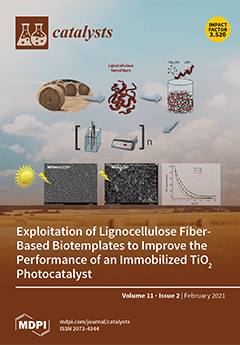Ultrahigh molecular weight polyethylene (UHMWPE) is a class of high-performance engineering plastics, exhibiting a unique set of properties and applications. Although many advances have been achieved in recent years, the synthesis of UHMWPE is still a great challenge. In this contribution, a series
[...] Read more.
Ultrahigh molecular weight polyethylene (UHMWPE) is a class of high-performance engineering plastics, exhibiting a unique set of properties and applications. Although many advances have been achieved in recent years, the synthesis of UHMWPE is still a great challenge. In this contribution, a series of zirconium and hafnium complexes, [2,6-(R
1)
2-4-R
2-C
6H
2-N-C(camphyl)=C(camphyl)-N-2,6-(R
1)
2-4-R
2-C
6H
2]MMe
2(THF) (
1-Zr: R
1 = Me, R
2 = H, M = Zr;
2-Zr: R
1 = Me, R
2 = Me, M = Zr;
1-Hf: R
1 = Me, R
2 = H, M = Hf;
2-Hf: R
1 = Me, R
2 = Me, M = Hf), bearing bidentate NN ligands with the bulky camphyl backbone were synthesized by the stoichiometric reactions of α-diimine ligands with MMe
4 (M = Hf or Zr). All Zr and Hf metal complexes were analyzed using
1H and
13C NMR spectroscopy, and the molecular structures of complexes
1-Zr and
1-Hf were determined by single-crystal X-ray diffraction, revealing that the original α-diimine ligand was selectively reduced into the ene-diamido form and generated an 1,3-diaza-2-metallocyclopentene ring in the metal complexes. Zr complexes
1-Zr and
2-Zr showed moderate activity (up to 388 kg(PE)·mol
−1(M)·h
−1), poor copolymerization ability, but unprecedented molecular weight capability toward ethylene/1-octene copolymerization. Therefore, copolymers with ultrahigh molecular weights (>600 or 337 × 10
4 g∙mol
−1) were successfully synthesized by
1-Zr or
2-Zr, respectively, with the borate cocatalyst [Ph
3C][B(C
6F
5)
4]. Surprisingly, Hf complexes
1-Hf and
2-Hf showed negligible activity under otherwise identical conditions, revealing the great influence of metal centers on catalytic performances.
Full article





